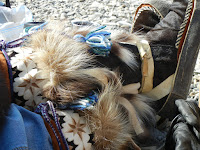Not only is the third day of the feast the longest day, it is chock full of activity from sun up to sun up (remember, it's June above the Arctic Circle, there is no sun down).
We arrive on site at 8:30 a.m. and already the bustle is in full swing. Pots are boiling, ulus are being sharpened, the windbreaks are up and the crowd is beginning to gather. The cutting area is already surrounded by women beginning the task of cutting the various donations of meat, fish, and fowl into bite size pieces to be cooked and distributed to all who attend. It is quite a sight to behold.
 I walk into the area with fellow camper LA (like the city). (We had paired up on the four wheeler during the now infamous Cape Thompson trip, so our dynamic duo was a given whenever we had to ride somewhere.)
I walk into the area with fellow camper LA (like the city). (We had paired up on the four wheeler during the now infamous Cape Thompson trip, so our dynamic duo was a given whenever we had to ride somewhere.)We walked right up to the heart of the cutting action and set out to join in on the work. We were given latex gloves, our own ulus, and huge chunks of assorted parts to cut up.
Let me just say that I was somewhat amazed at the immediate acceptance of our presence. Think about it...here we are a couple of tanik (white) women who walk up and just join in. Certainly, we asked for help in how to do what we were doing, but in the long run,
 there was a general understanding that we probably knew how to cut up parts. Here's the other thing: this was a huge undertaking. If someone wanted to help get the job done, woe to anyone who would not welcome that offering.
there was a general understanding that we probably knew how to cut up parts. Here's the other thing: this was a huge undertaking. If someone wanted to help get the job done, woe to anyone who would not welcome that offering. 
As I recall, I started out cutting up a whale heart valve, then progressed to the biggest tongue I'd ever encountered (also whale)! Then another heart valve came my way, but this time I really had to dissect it (wished I'd paid a little more attention in Biology class). Then, I finally got the big payoff as the meat from the ugruk our crew had caught was placed before me. I gently unlashed the string that held it folded together. This was the end of our story with our ugruk, and I had been able to be a part of it through this final chapter.
As we progressed, someone would come by and pick up the pieces we had cut, put them in a huge bowl, and carry them off to the cauldrons.
 |
| Me and LA |
Periodically, someone would come by and tell us the pieces we'd cut were too big, so we'd start cutting them smaller. Then a little while later someone else would come by and tell us the pieces were too small, so we'd start cutting them bigger. We had a lot of fun with that cycle all day long!
All around us, an amazing support system was in operation. Out by the pots, some of the men kept the wood pile stocked. As I mentioned, at the cutting board we had the runner who picked up the cut pieces. There was also: the garbage bag carrier to gather up discarded parts, the Angel who passed out hot coffee, the purveyor of soda pop, the shares distributor (we always had our Ziplocs at the ready), the hot donut distributor (never before have donuts been THAT good) and always someone was bringing by yet more hunks of parts to cut up. Seriously, the mountain never seemed to diminish.
 |
| Unalik, YUM! |
Periodically, food would be brought to us hot off the fire. When they brought by the unalik (boiled whale blubber and skin) it just hit the spot. Take a look at our pictures. It was not warm out. We were wearing long underwear, under our regular pants which were under our waterproof pants. That jacket I'm wearing is down and I've got a down sweater and fleece vest under it. At the point we chowed down on unalik, we'd already been cutting for a couple of hours. The hot morsel, full of nutrients was just the thing to keep us going for what turned out to be another three hours.
 |
| Hank's sister, Shirley |
I know I'm making it sound like all we did was eat, but these food breaks happened over a span of five hours.

Some of the women went the distance and kept cutting the entire time, others took shifts for as long as their knees and backs could stand it. LA and I persevered throughout the day. Frankly, when we looked around us and saw our "sisters" in it for the long haul, we decided we weren't leaving until they did. All ulus were finally surrendered at 1:30 p.m. amid a sea of smiling faces and a sense of overwhelming accomplishment.











































